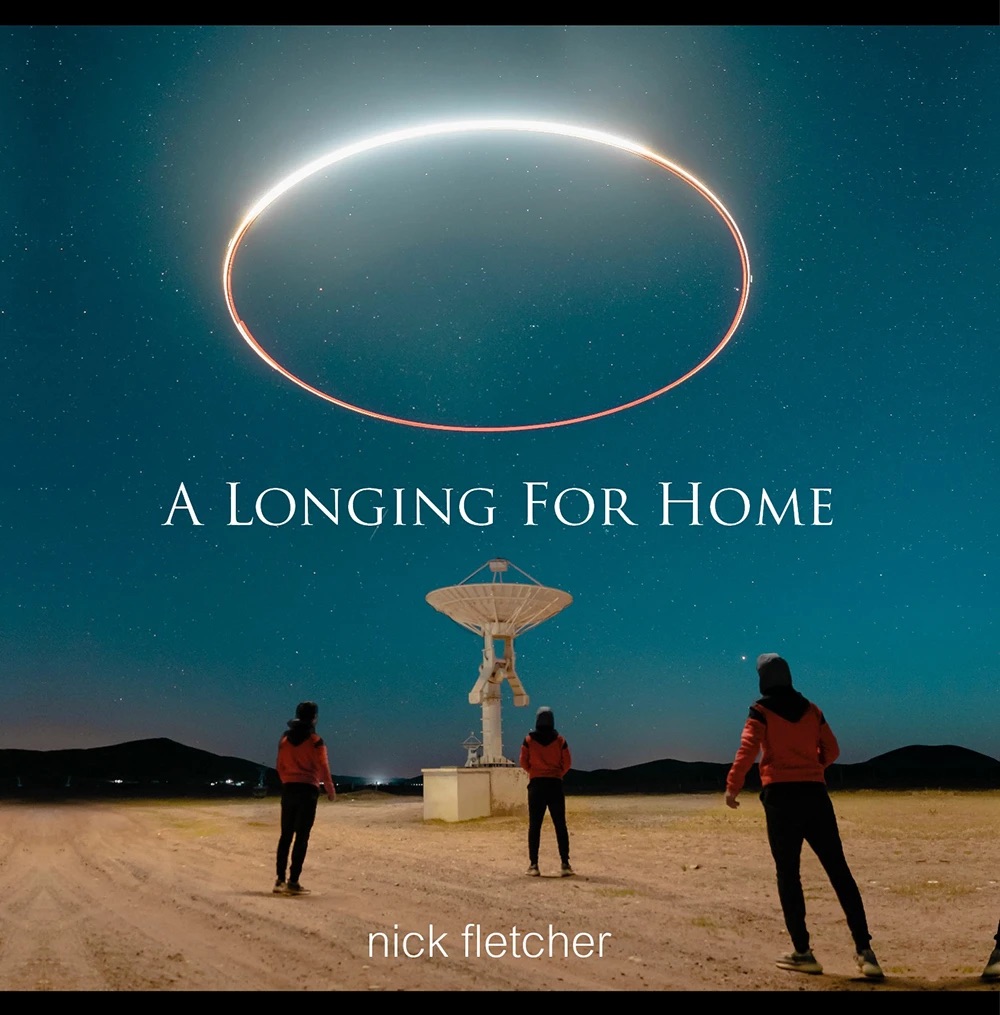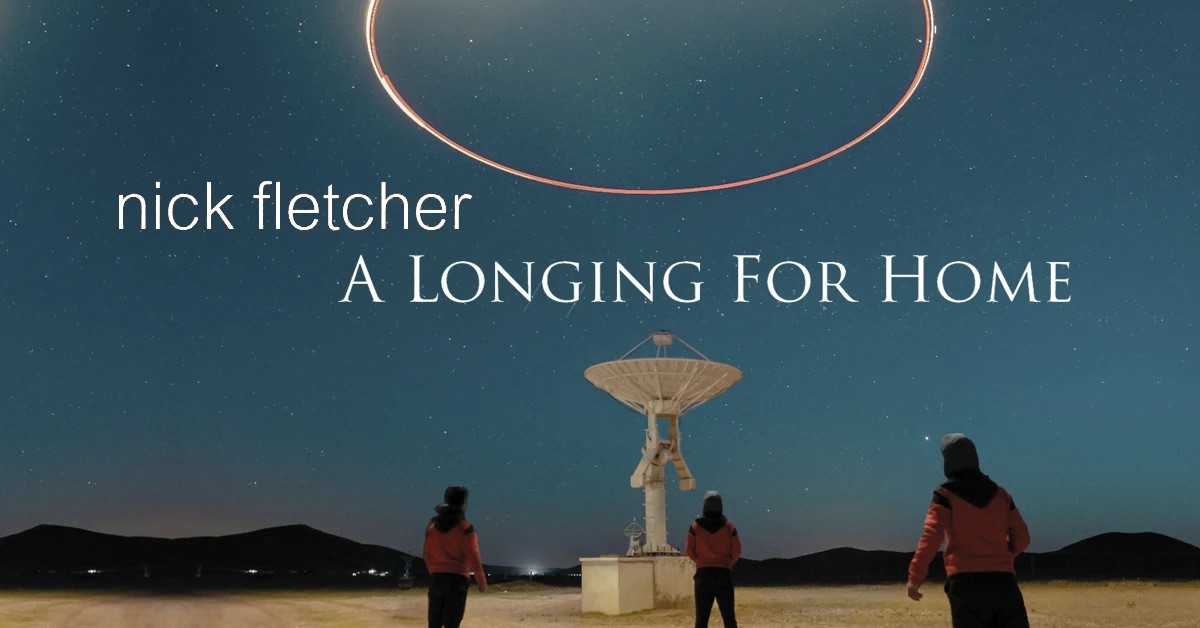- Artikel
- Lesezeit ca. 6 Minuten
Nick Fletcher – A Longing For Home – review
A Longing For Home is Nick Fletcher’s (John Hackett Band) fourth album in four years.rn

A Longing For Home is Nick Fletcher’s (John Hackett Band) fourth album in four years.
Preface
It’s becoming a habit for Nick Fletcher to delight listeners every year with a work from the fusion-jazz-progressive rock genre. Where the man gets his time and creativity from is a mystery. After all, the likable Englishman from Sheffield also produces music in the classical/acoustic genre, plays with the John Hackett Band, and teaches music. Not to mention countless live performances.
Background / Album Title
With A Longing For Home, Nick Fletcher presents a concept album that encompasses the search for home within us and in the universe. One could say he embarks on journeys into inner and outer space. The songs form a ten-part suite, so thematic and musical repetitions are intentional. The first title, Satori, already shows that the concept of Zen Buddhism, with its inward-looking approach to living in harmony with the outside world, is a travel accessory.
The Cover Artwork
 The cover leads us into a steppe-like landscape that transitions into a vast sky. Three people stare up at a lens-like structure that fills the firmament. Is this possibly a passage to the light, to the stars? The sci-fi touch is emphasized by a radio telescope in the background. A reminiscence of the SETI project, which searches for extraterrestrial life? The three figures in their training suits look like astronauts. They seem ready to go through the celestial gate. The lens-like object is reminiscent of the cover artwork of the previous album. There, a person stands in front of a light-flooded passage. The booklet also shows, among other things, a Romanesque chapel, photos of the musicians, and (particularly impressive) the stargate (or the sun during a solar eclipse) towards which a hand reaches out longingly. This is not surprising, as A Longing For Home is closely thematically connected to its two predecessor albums. Nick has again worked on the photos and layout, and as always, liner notes are included. Why do I go into such detail about the artwork? In my opinion, it shows the viewer the intentions of the instrumental music: The path that humans must take to find themselves. Inner harmony is the prerequisite for living in harmony with the outer world. The view into our stellar home in the universe opens the gate to knowledge. Journeys into the inner self, which Buddhism can help us with, merge with the rational, scientific view into space. To where our home is, where our destiny awaits.
The cover leads us into a steppe-like landscape that transitions into a vast sky. Three people stare up at a lens-like structure that fills the firmament. Is this possibly a passage to the light, to the stars? The sci-fi touch is emphasized by a radio telescope in the background. A reminiscence of the SETI project, which searches for extraterrestrial life? The three figures in their training suits look like astronauts. They seem ready to go through the celestial gate. The lens-like object is reminiscent of the cover artwork of the previous album. There, a person stands in front of a light-flooded passage. The booklet also shows, among other things, a Romanesque chapel, photos of the musicians, and (particularly impressive) the stargate (or the sun during a solar eclipse) towards which a hand reaches out longingly. This is not surprising, as A Longing For Home is closely thematically connected to its two predecessor albums. Nick has again worked on the photos and layout, and as always, liner notes are included. Why do I go into such detail about the artwork? In my opinion, it shows the viewer the intentions of the instrumental music: The path that humans must take to find themselves. Inner harmony is the prerequisite for living in harmony with the outer world. The view into our stellar home in the universe opens the gate to knowledge. Journeys into the inner self, which Buddhism can help us with, merge with the rational, scientific view into space. To where our home is, where our destiny awaits.
Participating Musicians
The contributors to the album are (as always) co-producer and mixer Caroline Bonnett: Keyboards, Anika Nilles: Drums, Jonathan Ihlenfeld Cuniado: Bass, Jan Gunnar Hoff: Keyboards, Olga “Dikajee” Karpova: Vocals on To Hear the Angels Sing. This is an international ensemble of wonderful musicians.
The Songs
Satori [5:33]
Crashing drum rolls open the piece. Nick’s guitar immediately takes command. The inner enlightenment appears with a jubilant jazz rocker that whirls variously. At 2:25, a quiet interlude interrupts, but ends with an insane guitar solo. Up and down it goes until minute 3:25, when the bass pays its respects for a short time. Is it dueling with a bubbling keyboard? Before we can ponder this, the music returns to its main motif under the guitar’s lead. Finally, ambient-like sound collages end an exciting tour de force.
The Secret Of The Ascent[6:17]
The solo guitar creates a wonderful jazz-rock atmosphere à la Mahavishnu Orchestra or Weather Report, which is replaced by a Hammond and drifts into rocky terrain. Deep Purple with jazz sounds? The keyboards dominate for about two minutes, then we hear again the currently best jazz guitarist in England, according to Steve Hackett. Alan Holdsworth would have enjoyed this solo. As the title suggests, the music rises in a continuous whirl, only to collapse into a quiet part.
Joy Turning Into Sorrow [1:48]
Sustained, quiet tones of an emotionally played acoustic guitar invite you to dream. Keyboard arpeggios let the short piece fade away. The right moment to catch your breath after the crashing opener.
Sitting In The Sunboat[7:32]
 A beautiful guitar line gently propels the sun boat. We hear astral waves slapping against the side of the boat, the solar wind blows around the boaters, we stare spellbound into the distance. Nick proves to us once again that he is a wonderful jazz guitarist. In the middle of the song, the keyboard gets space to solo, and how! The drums sound wonderful and drive forward the highlight of the album. A wonderful piece of music!
A beautiful guitar line gently propels the sun boat. We hear astral waves slapping against the side of the boat, the solar wind blows around the boaters, we stare spellbound into the distance. Nick proves to us once again that he is a wonderful jazz guitarist. In the middle of the song, the keyboard gets space to solo, and how! The drums sound wonderful and drive forward the highlight of the album. A wonderful piece of music!
Her Eyes Of Azure Blue [8:43]
Is that Peter Green playing? Isn’t this melody, which fills the room so gently, so softly whispering, from Peter Green’s wonderful In The Skies album? No, it’s Nick Fletcher, who incredibly sensitively caresses the strings of his guitar. How beautiful must be the blue eyes that Nick sings about… The music, which lies between blues, jazz, and Pink Floyd, certainly is. The equally gentle bass solo should be mentioned. Another masterpiece of the album, which with its almost nine minutes of playing time simply doesn’t want to end.
A Pathway To The Hermitage [5:40]
A guitar reminiscent of Marillion begins to whisper, to tick. The drums set the beat. Finally, it rocks, first hesitantly, then faster, with all its might. Yes, this is more prog than jazz. Steve Hackett is quoted, the late Brand X send their regards. The arpeggios of the guitar lead the way to the goal, the hermitage.
A Longing For Home[5:09]
Gliding, flowing sounds from keyboards and guitar create cosmic sounds. The gate to the stars seems to open. Here Nick is very close to David Gilmour. One is inclined to ask if the man can play everything, but the music quickly takes you into the light and answers this question.
The Sage, The Monk And The Scholar [5:07]
 Drums, bass, guitar, and keyboard discuss with each other, loud, hectic, arguing, complementing each other, a jazz-rock fusion number at its finest. Just listen to Nick’s solo from minute 2:15! Only the drums can withstand this, until the organ plays itself into the foreground. Is this metal jazz, or what?
Drums, bass, guitar, and keyboard discuss with each other, loud, hectic, arguing, complementing each other, a jazz-rock fusion number at its finest. Just listen to Nick’s solo from minute 2:15! Only the drums can withstand this, until the organ plays itself into the foreground. Is this metal jazz, or what?
Crossing The Sacred Threshold[6:36]
We return to the melody of the opener. It is taken up in various ways, playfully changed by guitar and keyboard. The circle closes. The sacred threshold is crossed. Inner and outer worlds unite. We go into the (musical) light. The Satori is fulfilled.
To Hear The Angels Sing [4:42]
Like a reprise, Nick lets the angels sing. Is it the harmonious, elf-like singing of Olga Karpova that brings us the light, accompanies it? Her soprano, filled with gentle sound paintings, ends the musical tour de force of the suite in a floating and dreamy manner.
Summary
In the review of the last album Quadrivium, I asked what would follow this wonderful work. The question is easy to answer. A Longing For Home represents the completion of Nick’s search for musical and spiritual fulfillment. Again, he amazes the listener with intelligent compositions full of joy of playing, love, and power. He has assembled an international ensemble of wonderful musicians who harmoniously blend into the sound. Technically proficient with much warmth and empathy, the theme of the work is celebrated. Nick doesn’t reinvent fusion-jazz rock-prog music, but gains surprising aspects from it. He demands intensive listening, coupled with the desire to engage with his philosophy. When you do that, you immerse yourself in the treasure of global human knowledge, philosophy, and religion. Here, the music reconciles the Western rational scientific path to knowledge with Far Eastern spiritual wisdom. Especially against the background of the current world situation, a hopeful approach. This inspiring music by Nick Fletcher invites discovery. Those who engage with his total work of art might perhaps find the way to the stars. Who knows?
From the linernotes
Once again, Nick cites a poem by Samantha Turner8:
A Longing For Home
Following an ache in my heart
I am longing for a place I once dwelled
Travelling precariously through the Kuiper Belt
I collide with every version of myself
We communicate in colour
I am them and they are me
All dimensions of time and space
Exist and yet cease to be
We speed across the star road
Guided by the whispers
Back to our ancestral home
Among the seven sisters
The star system called Plejades
In the origin of our birth
Before we existed
We descended to the Earth
I learn we all made of stars
Lost children from the sky
For when the ships ascended
Our group was left behind
Time incomprehensible
Erased our memory
But some innate recollection
Still lives inside of me
References
About Satori
Seti Institute – info
More about Anika Nilles
More about Jonatzhan Ihlenfeld Cunado (Facebook)
More about Jan Gunnar Hoff
More about Olga Karpova (Dikajee)
More about Samatha Turner
Author: Thomas Jesse

